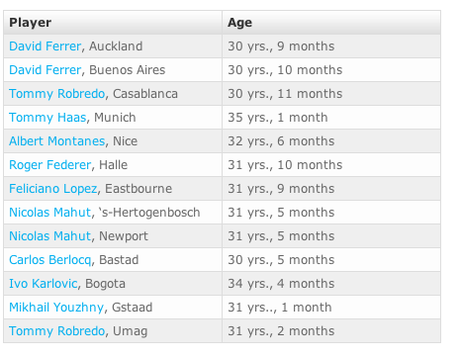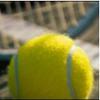Here’s a stat for you: The average age of the top 10 has steadily been increasing since 1992.

[Source: ESPN.com]
Boris BeckerLleyton HewittPete SamprasWhy The Changing Age Curve in Tennis?
So here we are today wondering if players will retire at 35. For doubles players, this number is 40. There are lots of theories about why this has happened and here are some of them:
1. Money
With prize money at an all time high, winning a few rounds at a Grand Slam or Master Event is worth the airline ticket. If a player makes it to round 1 in a Master event, he gets $10,000. You make a name for yourself and with endorsements and appearance fees, they are set for life.
2. Fitness and Nutrition
Never mind a coach, a top player needs a fitness coach and nutritional coach. The top 5 know this better than anyone. They don’t party (much), are leaner than a Gazelle and rae back in the gym the day after Christmas. There is no other way if you want to win in 5 against Nadal.
3. Kinesiology
Feet are very important in tennis and good shoes are critical. Developments in how the foot moves in relation to shoes are high tech and the pounding the players place on their feet is relentless. Clay courters especially have benefitted from this.
4. Surgeries
Advances in the medical field mean that a player’s shoulder or knee can be re-constructed back to former glory. Just look at Tommy Haas, who has had multiple surgeries and is threatening the top 10 again at 35 years old. Time out of the game for injuries might have helped too though and preserved some of the mileage, just look at the perma-injured Brian Baker.
5. Singles or Doubles
With a few exceptions like Jurgen Melzer or Michael Llodra, to be a top singles or double player something has to take a back seat. Daniel Nestor at 40 is the best doubles player because there is less running in doubles and the stress and strain of singles is not a factor. Sure, a top singles player might play Davis Cup doubles or enter a Grand Slam for the fun if it, but there is no real motivation to keep both up.
6. Mental Maturity
If 30 is the new 20, then 20 must be the new 10 and 10 is not the peak of emotional maturity. So that’s gone a bit far but you get the point. By 30, the distractions of life on the road should have tempered and all the pieces should be coming together such as the lessons in defeat, the savoring of success and all that jazz. Today’s game is physically and mentally tough and it takes a few more years now to get it all together.
7. Work Ethic
This is simply all of the above added together. Work in the gym, on the practice court, on the mind and on the body. Today’s professionals are just that – professional like any other profession. You just have to look at the slim margin of error. If Roger Federer takes his foot off the gas or has a small injury, he’s losing to players outside the top 100. the competition is that intense, even for a legend.
Here are the 2013 title winners so far, I’m sure there will be more before the year’s out:

[Source: ATP World Tour]

